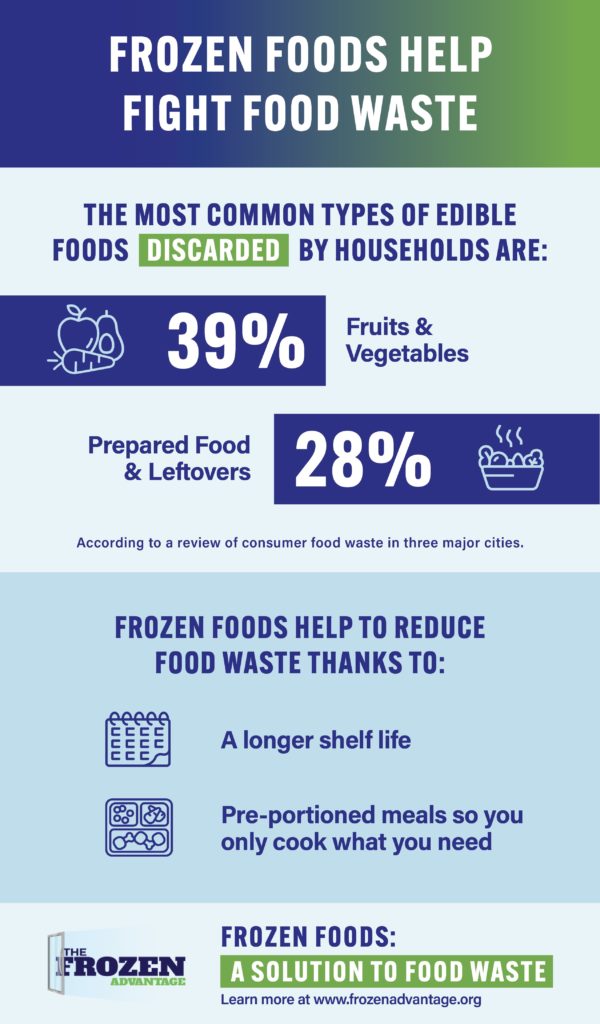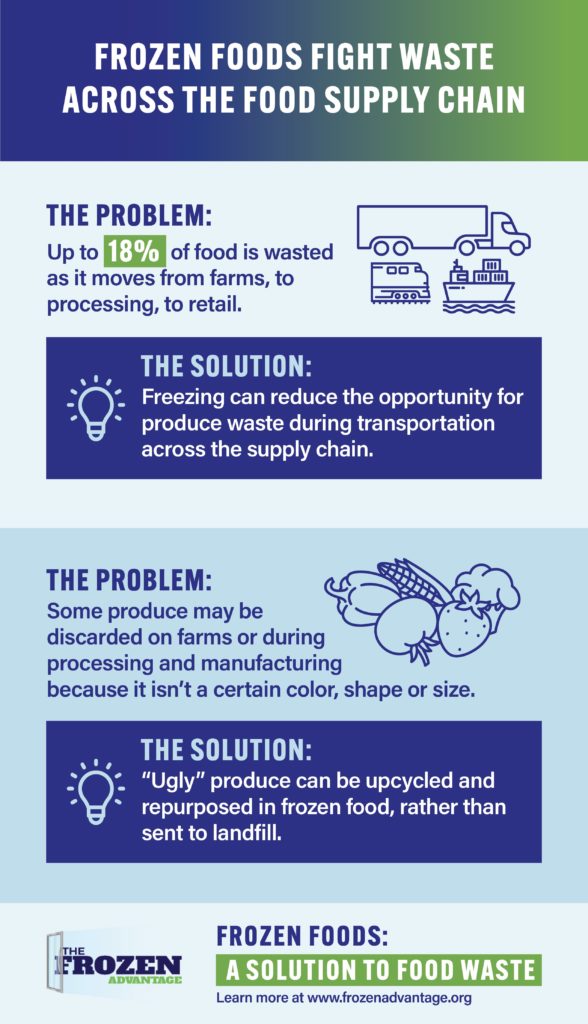In 2021, AFFI surveyed external stakeholders and industry members to identify where the frozen food industry has an opportunity to prioritize near-term action on environmental topics. This materiality assessment identified food waste as a priority topic issue and area for engagement among retailers, suppliers and policy influencers. Food waste is a significant problem globally and in the U.S. where $162 billion worth of food is wasted each year at the retail and consumer level alone. Around 30 – 40% of food is never consumed.
Why does this matter?
- 38 million people, including 12 million children in the United States alone are hungry or food insecure. It is unacceptable to waste food when so many in this country are food insecure.
- Food is the single largest component of U.S. landfills, accounting for 22 percent of municipal solid waste. In landfills, decomposing food produces methane, a greenhouse gas that contributes significantly to climate change. The Food and Agricultural Organization of the United Nations (FAO) estimates global food waste generates 8% of all greenhouse gas
- Many resources are used to grow food that is never consumed. For example, as much as 21% of fresh water is wasted on food that is discarded.
Reducing food waste is a “win-win.” Fewer people go hungry, less food goes to landfills and less greenhouse gas is emitted.
Reducing Food Waste: Frozen Food Helps People and the Planet
Making the most of the food we grow and buy is just common sense and has never been more important given the strain inflation has placed on family budgets. Doing so benefits consumers and the planet.
In a review of consumer waste in three major metropolitan cities, the two most common types of edible food discarded by individuals are fruits and vegetables (39%) and prepared food and leftovers (28%) – accounting for a large majority of wasted food among households.
Frozen food is part of the solution to food waste:
- Value: Frozen foods are often lower in cost-per-serving and have a much longer shelf-life than refrigerated or fresh foods. As a family of four can discard up to $1,500 worth of food each year, frozen food can help reduce those losses.
- Practical: With pre-portioned servings and a longer-lasting product, shoppers can take only what they need from the freezer when preparing a meal. This means fewer leftovers that go uneaten, less produce that spoils and proteins that don’t expire as quickly. Unused meal portions and ingredients can remain in the freezer for later use at another time.
- Effective: Research published in the British Food Journal shows that frozen foods generate 47% less food waste in the home compared to ambient and chilled food.
- Reducing Solid Waste: Research shows that 70% of secondary, outer packaging used for frozen foods is completely recyclable. Those recycled materials further reduce solid waste and help contribute to a circular model for frozen food packaging, which in turn reduces C02 emissions caused by composting.
Data indicate that consumers are recognizing the value of frozen food at home. In market survey research conducted in 2022, more than 80% of consumers said that using frozen fruit and vegetables helped them to cut down on food waste.
To help further reduce waste, AFFI supports industry-wide standard labeling systems to reduce confusion among consumers. AFFI supports using the “BEST if Frozen or Used By” and “Freeze or USE By” labels. The “BEST if Used By” label will indicate to consumers that after the specified date, the product may not taste or perform as expected but is still safe to consume. The “Freeze or USE By” date will inform consumers that the products should be frozen or consumed on or before the date listed on the package.
Frozen Helps Fight Waste Across the Food Chain
After crops are harvested, waste can occur across the food chain as the product moves from processing to retail. This can sometimes mean that food is moved across the country or even around the globe before it arrives on a grocery store shelf. Freezing is a powerful tool to reduce waste during post-harvesting, processing and transport, and can extend the marketability of products that otherwise might not be sold at the grocery store.
- Transportation: Freezing reduces the likelihood that produce is wasted during transportation between processing, distribution and retail.
- Marketability: Freezing allows for produce to be used that may otherwise be discarded on farms or during processing or manufacturing, whether because it’s surplus product or “ugly” produce that doesn’t meet fresh specifications on color, shape or size. The upcycling process – in which foods that would be otherwise thrown out are repurposed for a high-value use – diverts perfectly edible excess food to be sold and eaten rather than sent for disposal. For example, a bag of chopped, diced or riced broccoli may include parts of the stalk that otherwise would have been thrown out during manufacturing or at home.
From farm to freezer, frozen food can help all aspects of the food supply chain meet sustainability goals by minimizing food waste. Visit www.frozenadvantage.org for more information about how frozen food helps households and is a winning mealtime solution.


